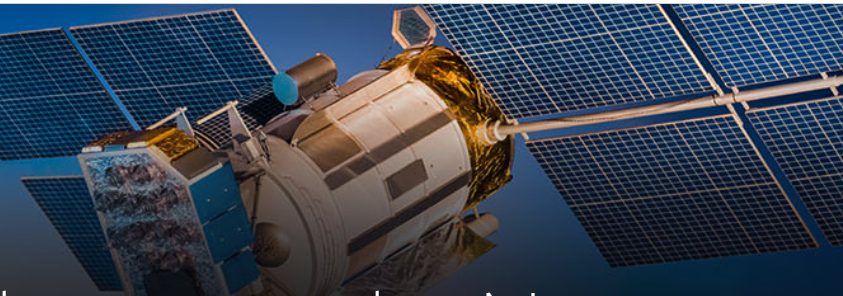Rummet bliver en del af investorernes hverdag, fordi rummet får en voksende betydning, også for private virksomheder. Kommunikation og digitalisering er blevet integreret med satellitter, og private virksomheder får bedre adgang til at sende udstyr i rummet. Antallet af satellitter vil vokse med 50 pct., vurderer Morgan Stanley. Rummet er blevet så integreret med jordiske virksomheder, at investorerne skal skelne mellem gammel og ny tænkning omkring rummet.
5 Key Themes in the Space Economy
Climate change, security and telecoms are among the key themes driving a boom in the space economy. Here’s a look at what’s behind the increased interest.
The rush to explore the expanding frontiers of the space economy is accelerating, with sustainability- and government-related applications driving critical growth and private investment.
“If I had to pick just three words to capture my conversations in this arena, it would be ‘space is existential,’ from the future of the planet to the future of commerce,” says Adam Jonas, Head of the Morgan Stanley Research Space Team.
For example, satellites are now providing a clearer view of how industries and human activities are intensifying climate change, while communications, navigation and national security issues dominate governments’ growing interests in space.
To advance the conversation on space development and capital markets, Morgan Stanley Research recently gathered corporates, government representatives and venture-capital participants for its third Annual Space Summit. For investors, here are five key themes that emerged from the summit:
1. A Growing Relationship Between Space and Climate Change
Space and sustainability have aligned. With more investors focused on environment, social and governance (ESG) factors, satellite imagery may provide them with key data on the environmental impact of company activities. Satellite applications include monitoring greenhouse-gas emissions from companies and regions, helping utilities optimize renewable energy infrastructure and mining data to project how climate change could affect particular industries.
“ESG is becoming table stakes for businesses, and satellite imagery helps fill the data gap,” says Jonas. “Developing technologies from both public and private companies could offer a new channel of information for investors interested in pursuing both sustainability and returns.”
2. Increased Capital Formation
Despite COVID-19, last year saw the biggest private investment in space to date, with space capital formation and infrastructure developing on multiple fronts.
First, investors are rethinking “old” vs. “new” space. It’s now less about the disruption and replacement of traditional players, and more about how the capabilities of new entrants complement them. “There’s enough room for the exquisite legacy capabilities of aerospace outfits and the more affordable new commercial players,” says Jonas.
Second, SPACs—special purpose acquisition companies—may be a potentially well-suited mechanism to attract capital for long-horizon business models in space.
Finally, the space industry now regards private corporate involvement in the sector more positively. As government entities like NASA set their sights on ambitious missions, such as Mars exploration, private companies are focusing on low-Earth-orbit transportation, satellite launches and commercial human spaceflight. Government agencies are also welcoming greater involvement from the investment community to develop the commercial potential of space and space-related markets.
“We’ll likely see more strategic partnerships in 2021 as aerospace/defense companies and new commercial players provide integrated solutions,” says Jonas.
3. Mitigating Orbital Debris
According to the U.S. National Oceanic and Atmospheric Administration, the number of active satellites in orbit is set to vastly increase by 50% or more in the years ahead. As space becomes more congested, the threat of “space junk”—orbital debris from old spacecraft and satellites—to new satellites and rocket launches has grown. Some government agencies now struggle to track this orbital debris, creating potential demand for private companies to monitor and manage this potentially catastrophic space waste.
4. Space and Security
Space has become an increasingly contested domain among countries, underscoring the need for “space domain awareness” by private and governmental players. That means identifying, characterizing and understanding objects in orbit.
In the U.S., space could therefore become less of a partisan issue. Satellite providers, for example, see their services cutting across political lines to address issues important to everyone, including national security and bridging the digital divide. While the Biden administration could pressure defense budgets, space will likely stay at the forefront.
5. Telecoms a Near-Term Focus
Satellite operators see value across all three orbital altitudes—GEO, MEO and LEO (Geostationary Equatorial Orbit, Medium Earth Orbit and Low Earth Orbit, respectively)—with companies taking different approaches to blending them.
GEO still underpins the industry, but telecoms also want to provide differentiated broadband services with integrated, seamless offerings for consumer, business and government customers.
Telecoms will also need to work with regulators at the U.S. Federal Communications Commission and the UN’s International Telecommunication Union to treat space as a shared global resource, with spectrum rights and orbital debris being two key issues.
Within LEO, the telecoms industry continues to debate optimal satellite constellation design and the best end markets. They are also taking different approaches to the various markets, such as aerospace, in-flight connectivity for commercial airlines and maritime communications and navigation. Some telecoms prefer a direct, integrated approach, while others see value in service partnerships.





